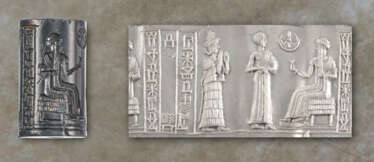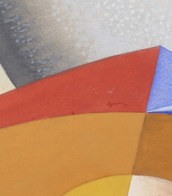bergamini



Atanasio Soldati was an Italian abstractionist painter.
In the 1930s he worked alongside Picasso and created in the Cubist style. Soldati then became a central figure in Italian abstractionism. In 1948, together with Bruno Munari, Giello Dorfles and Gianni Monnet, he created the Concrete Art movement.


Ennio Morlotti is an Italian abstractionist painter.
Morlotti studied painting at the Academy of Fine Arts in Florence and at the Accademia di Brera in Milan. In 1947 he was one of the founders of the post-war New Front for Art (Fronte Nuovo delle Arti) movement.


Felice Casorati was an Italian painter. The future painter originally studied piano, then graduated from the Faculty of Law at the University of Padua. At the same time he took painting lessons, first in Pavia, and from 1908 in Naples. In 1907 and 1909 held exhibitions of his paintings in Venice.
Felice Cazorati's work is strongly influenced by Symbolism and the Art Nouveau style (especially Gustav Klimt). In the early 1920s, the artist embraces the metaphysical realism of Giorgio de Chirico and uses his principles of spatial construction on the canvas. Later in the 1920s, he studied Renaissance art (in particular the works of Piero della Francesca). He painted still-lifes, genre and religious paintings, women's portraits and nudes, and also worked as a theatrical artist.
At the end of the 1920s, Felice Cazorati opened his own art school in Turin, and also taught at the Turin Academy of Art.

_-_BEIC_6346831.jpg)


Atanasio Soldati was an Italian abstractionist painter.
In the 1930s he worked alongside Picasso and created in the Cubist style. Soldati then became a central figure in Italian abstractionism. In 1948, together with Bruno Munari, Giello Dorfles and Gianni Monnet, he created the Concrete Art movement.


Atanasio Soldati was an Italian abstractionist painter.
In the 1930s he worked alongside Picasso and created in the Cubist style. Soldati then became a central figure in Italian abstractionism. In 1948, together with Bruno Munari, Giello Dorfles and Gianni Monnet, he created the Concrete Art movement.




Ennio Morlotti is an Italian abstractionist painter.
Morlotti studied painting at the Academy of Fine Arts in Florence and at the Accademia di Brera in Milan. In 1947 he was one of the founders of the post-war New Front for Art (Fronte Nuovo delle Arti) movement.


Atanasio Soldati was an Italian abstractionist painter.
In the 1930s he worked alongside Picasso and created in the Cubist style. Soldati then became a central figure in Italian abstractionism. In 1948, together with Bruno Munari, Giello Dorfles and Gianni Monnet, he created the Concrete Art movement.


Massimo Campigli was an Italian painter and writer. He was studied art in Florence and Paris.
Campigli's art was heavily influenced by the Cubist and Surrealist movements, and his paintings often featured bold, geometric shapes and stylized figures. He was known for his use of bright colors and flat planes of color, which gave his work a sense of depth and dimension.
In addition to his art, Campigli was also a writer, and published several books and essays on art and literature throughout his career. He was a member of the Italian Communist Party, and his political beliefs often informed his work.
Campigli's art was widely exhibited throughout Europe and the United States during his lifetime, and he received numerous awards and honors for his contributions to the arts.
Today, Campigli is considered one of the most important Italian painters of the 20th century, and his work continues to be studied and exhibited around the world. His legacy has had a significant impact on the development of modern and contemporary art.


Filippo de Pisis, actually Luigi Filippo Tibertelli was an Italian painter, graphic artist, writer and poet close to the school of metaphysical painting. From 1914 he studied at the University of Bologna, where he studied literature and philosophy.
Filippo de Pisis was a painter of the Italian Novecento. He is considered a representative of Italian futurism in painting. His work is post-impressionist and partly expressive.


Filippo de Pisis, actually Luigi Filippo Tibertelli was an Italian painter, graphic artist, writer and poet close to the school of metaphysical painting. From 1914 he studied at the University of Bologna, where he studied literature and philosophy.
Filippo de Pisis was a painter of the Italian Novecento. He is considered a representative of Italian futurism in painting. His work is post-impressionist and partly expressive.


Filippo de Pisis, actually Luigi Filippo Tibertelli was an Italian painter, graphic artist, writer and poet close to the school of metaphysical painting. From 1914 he studied at the University of Bologna, where he studied literature and philosophy.
Filippo de Pisis was a painter of the Italian Novecento. He is considered a representative of Italian futurism in painting. His work is post-impressionist and partly expressive.


Renato Guttuso was a twentieth-century Italian painter and graphic artist. He is known as a brilliant representative of neo-realism.
Renato Guttuso was one of the founders of the "New Art Front". - a revolutionary artistic movement that emerged in Italy after World War II.
Guttuso's paintings have a pronounced social orientation, his work combines Expressionism, Cubism and Realism. He also designed sets and costumes for the theater and created illustrations for books.


Ennio Morlotti is an Italian abstractionist painter.
Morlotti studied painting at the Academy of Fine Arts in Florence and at the Accademia di Brera in Milan. In 1947 he was one of the founders of the post-war New Front for Art (Fronte Nuovo delle Arti) movement.


































































